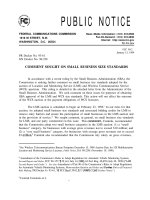Business Blueprints: Is Your Business Idea Feasible? pptx
Bạn đang xem bản rút gọn của tài liệu. Xem và tải ngay bản đầy đủ của tài liệu tại đây (1.29 MB, 60 trang )
U A L R
◆◆◆
Business Blueprints:
Is Your Business Idea Feasible?
Arkansas
Small Business
Development Center
ASBDC
Arkansas
Small
Business
Development
Center
A partnership program with the
U. S. Small Business Administration and
the University of Arkansas at Little Rock
College of Business Administration
© 2002 ASBDC
All Rights Reserved
This publication was originally published with financial support from
SBC Communications Inc.
ASBDC
Revision 2/02
T
ABLE
O
F
C
ONTENTS
INTRODUCTION 1
IDENTIFY PERSONAL OBJECTIVES, SKILLS, AND RESOURCES
Step 1. Identify Your Personal Objectives 5
Step 2. Identify Your Personal Skills and Experience 7
Step 3. Identify Your Personal Financial Resources 9
DESCRIBE BUSINESS IDEA AND REQUIREMENTS
Step 4. Describe Your Product or Service 14
Step 5. Describe Your Customer 16
Step 6. Describe Your Competition 18
Step 7. Describe Your Sales and Distribution Process 20
Step 8. Describe Your Management Requirements 26
Step 9. Develop Your Sales Forecast 28
Step 10. Identify Your Start-up Expenses 30
Step 11. Estimate Your 12-Month Operating Budget 32
STEP 12. EVALUATE BUSINESS FEASIBILITY
Market Scoresheet 45
Management Scoresheet 46
Money Scoresheet 47
CONCLUSION 49
APPENDIX
Reference List 51
Nine Commonly Asked Questions 55
I
NTRODUCTION
• Do you want to start a business?
• Do you want to see if your business idea will be profitable?
• Do you want to know if your business idea will meet your personal objectives?
• Do you want to get financing to start your business?
If your answer is “YES” to any of these questions, then this business feasibility workbook is
for you.
Starting a business is something that many Arkansans dream of — it’s one of the distinguishing
characteristics of our nation's free enterprise system. Turning this dream into reality, however, is not
an easy task. People are free to start businesses, but they are also free to fail.
The decision to start a business is an intensely personal one — no one can make it for you. To make the
right decision — the best one for you — you need to consider many elements about yourself and your
prospective business.
In general, a successful business has three parts: Market, Management, and Money.
Market: "Is there a market for my product or service?" You need to determine if you have
a market for your product. Without customers that will buy your product or service
in sufficient numbers and at a high enough price to provide a profit, the business
will fail.
Management: "Can I bring this product to market?" Products or services, however inherently
attractive, do not sell themselves or manage businesses. You must be able to
demonstrate to yourself and others that you have sufficient skill and experience to
manage your business and bring the product to market profitably.
Money: If the answers to the Market and Management questions are "Yes," then — and only
then — should you think about money. Too many people ignore the market and
management issues and focus only on money, but the survival of the business
depends on the market and the management. To overlook those issues will assure
business failure and an inability to secure financing.
The purpose of this workbook is to help you think about your business idea and perform an initial
business feasibility analysis. It will guide you through consideration of market, management, and money
questions. To analyze these areas adequately will take significant time and effort, but your work will
pay off many times over. Guided by this workbook, you can collect information necessary for business
success and the acquisition of financing.
- 1 -
I
NTRODUCTION
This workbook is not a guide to writing a business plan. That is an extensive process that varies from
business to business. Before you proceed to do a business plan, you should have already completed the
basic business feasibility analysis.
To assist you in working out a feasibility analysis, a list of useful reference materials has been included.
The list is organized according to that part of the feasibility analysis each reference item is most helpful
or appropriate for.
We recommend that you glance through all materials listed for each specific step since some items will
aid in filling out the questionnaires. Additional references not referred to in the text of the workbook
appear in the Step lists most appropriate.
- 2 -
T
HE
S
TEP
-B
Y
-S
TEP
B
USINESS
F
EASIBILITY
P
ROCESS
It is often helpful in the process of business feasibility analysis to be able to picture a step-by-step flow.
The chart shown below provides you a way to visualize some of the critical steps that need to be undertaken
before starting your business. Following the step-by-step process pictured in this flow chart can help make
sense out of what can be a detailed and sometimes confusing process.
While completing these steps does not guarantee success in business, your detailed attention to them will improve
your chances of success. They will help you evaluate your business idea before you or other people make a
financial commitment. The sections of this business feasibility workbook provide details for completing each of
the steps listed.
Market
Scoresheet
Money
Scoresheet
Management
Scoresheet
Step 11. Estimate Your
12-Month Operating
Budget
Step 4. Describe Your
Product or Service
Step 10. Identify Your
Start-up Expenses
Step 5. Describe Your
Customer
Step 6. Describe Your
Competition
Step 9. Develop Your
Sales Forecast
D
ESCRIBE
B
USINESS
I
DEA
AND
R
EQUIREMENTS
Step 1. Identify Your
Personal Objectives
Step 3. Identify Your
Personal Financial Resources
Step 2. Identify Your Personal
Skills and Experience
I
DENTIFY
P
ERSONAL
O
BJECTIVES
,
S
KILLS
,
AND
R
ESOURCES
S
TEP
12. E
VALUATE
B
USINESS
F
EASIBILITY
Step 8. Describe Your
Management Requirements
Û
Û
Û
Û
Û
Û
Û
Û
Û
Û
Û
Û
Û
Û
- 3 -
Step 7. Describe Your
Sales and Distribution
Process
I
DENTIFY
P
ERSONAL
O
BJECTIVES
, S
KILLS
,
AND
R
ESOURCES
- 4 -
NOTE: Objectives are very personal; each person’s will be differ-
ent. The importance of these lists is to make you think
about the real reasons you are considering starting your
own business.
When evaluating your business idea, one of the elements to consider is its ability to satisfy your wants
and needs. If it cannot, you will most likely be unhappy with the business, and an unhappy owner usually
makes a poor manager. Poor management is a leading cause of business failure.
Stating the risks you are willing to take for the potential rewards will help you decide whether the
business is right for you. Take a few minutes to identify the financial and personal needs objectives that
are important to you. Be honest with yourself!
S
TEP
1. I
DENTIFY
Y
OUR
P
ERSONAL
O
BJECTIVES
- 5 -
Annual vacations are important to my family and me. We never miss them. Yes____ No____
I like to leave my work at the office at the end of each day. I think about
it only when I return the next morning.
Yes____ No____
I am willing, and able, to concentrate on the business to the exclusion of
family and friends.
Yes____ No____
I am in good health and have no family members with health problems. Yes____ No____
I am comfortable with uncertainty, even if it means not being guaranteed
a regular paycheck.
Yes____ No____
I enjoy working with people, even disagreeable ones. Yes____ No____
I want to be my own boss. Yes____ No____
I want to become well-known in my community. Yes____ No____
I want to be the sole owner of my business. Yes____ No____
I am willing to take a partner/investor into my business. Yes____ No____
I must have a regular paycheck. Yes____ No____
I want to work __________ hours per day, __________ days per week.
I like to spend ________ hours per week engaged in my hobbies or other leisure-time activities.
I want to employ __________ people.
I want to employ __________ members of my family or friends.
I want to make $__________________ per year.
I must earn at least $__________________ annually.
I am willing to invest $______________ to start my business.
The skills I have and want to use in running my business are:
_________________________________________________________________________________
_________________________________________________________________________________
The jobs I want someone else to handle are:
_________________________________________________________________________________
_________________________________________________________________________________
The assets that I own and am willing to use as collateral on a business loan are:
_________________________________________________________________________________
_________________________________________________________________________________
_________________________________________________________________________________
I
DENTIFY
Y
OUR
P
ERSONAL
O
BJECTIVES
- 6 -
S
TEP
2. I
DENTIFY
Y
OUR
P
ERSONAL
S
KILLS
AND
E
XPERIENCE
Y
our business idea may be a very viable one, but without good management skills to execute it, your
chances for success are poor.
This does not mean that you must yourself possess all the necessary management skills. It does mean
that you must know your weak points, so that you can either acquire skills in those areas or hire someone
who has them. Be aware though that an overdependence on others may expose you and your business
to significant risk.
Your chances for success are usually much better if you have direct work experience in the type of
business you plan to start. Past experience provides key contacts in the industry or community that can
help as you establish your own operation. Past experience provides firsthand knowledge that cannot be
learned from a book. It gives you credibility.
The Management Skills Checklist on the next page identifies some of the skills that business owners need
in order to insure that they can adequately control their businesses. Evaluate how well prepared you are
to manage your business by checking the appropriate category under each skill.
Use the space below the checklist to list the name of the person who will provide any skill that you do
not have and will not obtain through training. For those skills you intend to learn, identify where and
when you plan to get training.
- 7 -
I
DENTIFY
Y
OUR
P
ERSONAL
S
KILLS
AND
E
XPERIENCE
I KNOW
HOW
I NEED
TRAINING
Management Skills Checklist
SKILLS
Establish & maintain financial records
Prepare operating budgets
Put together a loan proposal
Compile financial statements
Meet payroll & sales tax requirements
Analyze financial performance
Project & control cash flow
Purchase & manage inventory and/or supplies
Determine credit worthiness of customers
Collect past-due accounts
Price my product/service
Promote my product/service/business
Hire & train employees
Monitor employee performance
Motivate employees; build a team environment
Manage my time
Delegate work to others
Negotiate agreements/contracts with suppliers,
customers, etc.
Schedule production work, including labor,
machinery, & material needs
Install quality control methods & conduct
follow-up measurement
Meet basic legal requirements, including those
related to employment, zoning, safety/health,
waste disposal, etc.
Identify & make changes necessary to maintain
the business’s success
Names of people or places who will satisfy "I Need Training" requirements:
(See Step 8 for more information.)
________________________________________________________________________________
________________________________________________________________________________
________________________________________________________________________________
Names of people or places who will satisfy "Someone Else Will Do" requirements:
______________________________________________________________________________________________________________________________
________________________________________________________________________________
__________________________________________________________________________________________________________________________________________________________
SOMEONE
ELSE WILL DO
- 8 -
S
TEP
3. I
DENTIFY
Y
OUR
P
ERSONAL
F
INANCIAL
R
ESOURCES
A critical element in the analysis of your business idea’s feasibility is evaluating how much of the
business’s financial needs you can meet from your personal resources.
It is unrealistic to assume that you will be able to borrow all of the money you need to start your venture.
Virtually every lender — aside from family and friends — will require you to put in some money of your
own, either in the form of cash or assets. In order to determine whether you have an adequate amount
of money to put into the business, you need to summarize your personal financial resources.
Use the
Personal Financial Statement in Step 2 to identify your current financial condition.
Instructions for completing the Personal Financial Statement:
1. Specify the date for which information is given.
NOTE: You always need a personal balance sheet when you are attempting to borrow money.
Lenders require that your information be recent, so prepare your statement as of the latest
month for which you have information but not more than two months old.
2. List the dollar value of each of the Assets which you own. State market values for stocks and bonds, real estate,
automobile, other personal property, and other assets.
3. Add the Assets column and show the amount in the Total Assets blank. This is the value of all your properties
and possessions.
4. List the dollar amount of each of the Liabilities which you owe. Be sure to include credit card debts.
5. Add the Liabilities column and show the amount in the Total Liabilities blank. This is the total amount you
owe others.
6. Now, subtract the Total Liabilities amount from the Total Assets figure. The difference is your Net Worth,
the portion of your assets that exceeds the debt you owe others. Write this amount in the Net Worth blank.
Write the sum of the Total Liabilities and Net Worth amounts in the Total Liabilities and Net Worth blank
— this should equal the amount shown as Total Assets.
NOTE: If your total liabilities amount is more than the value of your total assets, you have a negative
net worth. In other words, you owe more than you have. It is unlikely you can borrow money
from conventional financing sources if this is the case.
7. Section 1: List all income amounts that you receive and describe their source. Also, identify any contingent
liabilities for which you may be liable. For example, if you have co-signed a note payable or personally
guaranteed a business debt, your dollar liability should be shown.
8. Section 2: List all notes payable to banks and others, including automobile notes.
- 9 -
9. Section 3: List all stocks and bonds which you own.
10. Section 4: List all real estate that you own. Identify the type of property, e.g., residence, rental house, timber
land, etc.
11. Section 5: List other personal property which you own. Examples include antiques, paintings, jewelry,
boats, farm or lawn equipment, and household furnishings.
12. Section 6: List other assets that you have as well as details on notes and accounts receivable. If you own
another business, list the value of your equity in the business.
13. Sections 7 and 8: Describe any unpaid taxes or other liabilities which you owe.
14. Section 9: Identify all life insurance policies which you or your spouse have.
I
DENTIFY
Y
OUR
P
ERSONAL
F
INANCIAL
R
ESOURCES
- 10 -
S
ECTION
2. N
OTES
P
AYABLE
TO
B
ANKS
AND
O
THERS
NAME & ADDRESS OF ORIGINAL CURRENT PAYMENT FREQUENCY HOW SECURED OR ENDORSED
NOTEHOLDER BALANCE BALANCE AMOUNT (MONTHLY, ETC) TYPE OF COLLATERAL
_____________________________________________________________________________________________________________
_____________________________________________________________________________________________________________
_____________________________________________________________________________________________________________
_____________________________________________________________________________________________________________
P
ERSONAL
F
INANCIAL
S
TATEMENT
A
S
OF
___________________, ______ (M
ONTH
, Y
EAR
)
Name _______________________________________________________ Residence Phone _________________________________________
Residence Address ________________________________________________________________________________________________________
City, State & ZIP _________________________________________________________________________________________________________
Business Name of Applicant/Borrower ________________________________________________________________________________________
L
IABILITIES
& N
ET
W
ORTH
(omit cents)
Accounts Payable ___________________
Notes Payable to Banks & Others
(Describe in Section 2) ___________________
Installment Account (Auto) ___________________
Mo. Payments $________
Installment Account (Other) ____________________
Mo. Payments $________
Loans on Life Insurance ___________________
Mortgages on Real Estate
(Describe in Section 4) ___________________
Unpaid Taxes
(Describe in Section 7) ___________________
Other Liabilities
(Describe in Section 8) ___________________
Total Liabilities ___________________
Net Worth ___________________
Total Liabilities & Net Worth ___________________
A
SSETS
(omit cents)
Cash on Hand & in Banks ___________________
Savings Accounts ___________________
IRA ___________________
Accounts & Notes Receivable
(Describe in Section 6) ___________________
Life Insurance-Cash Surrender Value Only ___________________
Stocks and Bonds
(Describe in Section 3) ___________________
Real Estate
(Describe in Section 4) ___________________
Automobile-Present Value ___________________
Other Personal Property
(Describe in Section 5) ___________________
Other Assets
(Describe in Section 6) ___________________
Total Assets ___________________
S
ECTION
1. S
OURCE
OF
I
NCOME
C
ONTINGENT
L
IABILITIES
Salary _________________ As Endorser or Co-Maker _________________
Net Investment Income _________________ Legal Claims & Judgements _________________
Real Estate Income _________________ Provision for Federal Income Tax _________________
Other Income (Describe)* _________________ Other Special Debt _________________
_____________________________________________________________________________________________________________
_____________________________________________________________________________________________________________
*(Alimony or child support payments need not be disclosed in "Other Income" unless it is desired to have such payments counted toward total income.)
- 11 -
S
ECTION
3. S
TOCKS
AND
B
ONDS
(Use separate sheet if necessary)
NUMBER OF SHARES NAMES OF SECURITIES COST MARKET VALUE DATE OF MARKET QUOTE
_____________________________________________________________________________________________________________
_____________________________________________________________________________________________________________
_____________________________________________________________________________________________________________
_____________________________________________________________________________________________________________
S
ECTION
4. R
EAL
E
STATE
O
WNED
(List each parcel separately. Use supplemental sheets, signed and dated, if necessary.)
NAME(S) DATE ORIGINAL PRESENT MORTGAGE PAYMENT STATUS OF
ADDRESS TYPE OF PROPERTY ON TITLE PURCHASED COST VALUE BALANCE AMOUNT MORTGAGE
_____________________________________________________________________________________________________________
_____________________________________________________________________________________________________________
_____________________________________________________________________________________________________________
_____________________________________________________________________________________________________________
S
ECTION
5. O
THER
P
ERSONAL
P
ROPERTY
(Describe, and if any is mortgaged, state name and address of mortgage holder and amount of mortgage,
term of payment, and if delinquent, describe delinquency.)
S
ECTION
6. O
THER
A
SSETS
, N
OTES
, & A
CCOUNTS
R
ECEIVABLE
(Describe)
S
ECTION
7. U
NPAID
T
AXES
(Describe, in detail, as to type, to whom payable, when due, amount, and any property the tax lien attaches)
S
ECTION
8. O
THER
L
IABILITIES
(Describe in detail)
S
ECTION
9. L
IFE
I
NSURANCE
H
ELD
(Give face amount of policies, name of company, and beneficiaries)
Signature Signature Date
Social Security No. Social Security No.
- 12 -
D
ESCRIBE
B
USINESS
I
DEA
AND
R
EQUIREMENTS
- 13 -
S
TEP
4. D
ESCRIBE
Y
OUR
P
RODUCT
O
R
S
ERVICE
It is important that you know, in your own mind, precisely what business you are going to engage in.
You may say "That’s obvious!" but in taking the time to collect your thoughts and write your idea down,
you may discover problems you had not anticipated and advantages you had not considered. While there
are hundreds of types of businesses, most can be classified into one of four main categories: service,
retail, wholesale, or manufacturing.
Service businesses are currently the most frequently established operations. They are similar to retail
businesses, though location is often less important and advertising is often more important than in retail.
Service operations usually sell a specialty or skill, so credibility is very important. Start-up costs are
often low, and many service businesses can be operated from the owner's home.
Retail stores are a common type of business start-up. Their main advantage is that they can be owned
and operated by one person with minimal assistance. Compared to manufacturing operations, they are
relatively easy to start, both financially and operationally. However, they have a high failure rate due
to undercapitalization, poor site location, and poor market analysis.
Wholesale operations serve as the link between the manufacturer of goods and the retail merchant,
industrial customer or end user. They take title to the products they sell and, thus, often have a larger
dollar investment in inventory. Location is important even though they often serve a large geographic
market.
Manufacturing start-up costs are higher and the setup times are longer than with the other three business
types. Cash may become a problem as the time span between purchase of raw materials and payment
for finished goods can be weeks and often months during which many fixed expenses must still be paid.
Also, manufacturing operations require more people, both for production and management, than all but
the largest of the other three types.
Most government and industry information for all lines of business is collected and reported by Standard
Industrial Classification (SIC) code*. This code is a four-digit number assigned by the U. S. government.
Identify your SIC code in the Standard Industrial Classification Manual so that you will be able to access
information available in reference materials and sources.
* The North American Industry Classification System (NAICS), approved in April, 1997, will replace
SIC and enable the NAFTA partners to better compare economic and financial statistics, keeping pace
with the changing economy. Data reported by NAICS will begin to appear gradually over the next
two to five years.
- 14-
D
ESCRIBE
Y
OUR
P
RODUCT
OR
S
ERVICE
What type of business am I planning to start? (service; retail; wholesale; manufacturing; etc.)
_________________________________________________________________________________
The SIC/NAICS code for my business is _______________________________________________
What will my business’ image be?
(quality and price of my products or services; the location and appearance
of my facilities; level of employee assistance to customers; types of customers I will sell to)
_________________________________________________________________________________
_________________________________________________________________________________
___________________________________________________________________________________
What specific products/services will I offer?
_________________________________________________________________________________
_________________________________________________________________________________
___________________________________________________________________________________
Are these products/services already available in the marketplace? If so, how and where? If not,
why not?_________________________________________________________________________
_________________________________________________________________________________
_________________________________________________________________________________
Will my products/services be different from what is already available? In what way?
(e.g., conven-
ience, quality, service, price)
___________________________________________________________
_________________________________________________________________________________
_________________________________________________________________________________
How will I deliver my product or service to the marketplace?_______________________________
___________________________________________________________________________________
What type of labor skills will I need to run my business? How will I be able to find them in my
area?_____________________________________________________________________________
_________________________________________________________________________________
___________________________________________________________________________________
What kinds of equipment or raw materials will I need to run my business or produce my product?
How available are these? ____________________________________________________________
_________________________________________________________________________________
_________________________________________________________________________________
Can my equipment be used to manufacture other products or produce other services?
_________________________________________________________________________________
_________________________________________________________________________________
Are there other services or products I could offer to increase my lines of business?
___________________________________________________________________________________
___________________________________________________________________________________
- 15 -
S
TEP
5. D
ESCRIBE
Y
OUR
C
USTOMER
Without customers, you will not have a business. Yet it is amazing how many companies know next
to nothing about the people or businesses who purchase their products or services. You have to know
who your potential customers are before you can determine how to sell to them.
When it comes to your potential customers, you need to know two things: what they are like and how
many of them exist in your target area. You must determine the characteristics that your customers have
in common. For consumers, these include things like age, occupation, marital status, income, number
of children, etc. For business customers, some characteristics to consider are dollar sales volume, type
of business, markets served, authority to make the buying decision, and location. Trade journals for
specific industries may include subscriber characteristics in their "media kits."
Unless you can find a competitor or industry association that has already gathered this information, you
will have to do it yourself. While there are a number of ways to go about characterizing potential
customers, they are too involved to cover in this workbook. There are excellent publications available
that explain how to do your own market research. Do-It-Yourself Marketing Research takes the mystery
out of gathering market data and using it to make sound decisions. The Insider's Guide to Demographic
Know-How tells you how to find, analyze, and use information about your customers. See reference list
included near the end of the workbook.
Once you have determined what your customer "looks like," you need to approximate how many of him
or her there are in your target area. Census data is an excellent source for this kind of information.
The Census State Data Center (CSDC), operated by the University of Arkansas at Little Rock, is the
official depository for federal census data. A telephone call is often all that is necessary to obtain census
information from this office. The CSDC can provide a more detailed analysis of the market for a
reasonable fee. The market analysis can include any of the population and housing characteristics
available from the most current Census and can be provided for a designated radius around a specific
site or for a user-defined geographic area. For additional information, contact the CSDC at 501-569-
8530.
Use a map to identify geographic markets. Based on your knowledge of who your primary customer
groups are, mark their location(s) on your map. You can use this visual aid later in evaluating possible
locations for your business.
- 16 -
Describe my customers in detail. (What will be their age? sex? income level? education? occupation?
marital status? location? etc. If customers will be other businesses, what types? sizes? location? etc.)
_________________________________________________________________________________
_________________________________________________________________________________
_________________________________________________________________________________
___________________________________________________________________________________
Why will customers buy my products/services?
(Possibilities include need, luxury, impulse, replacement,
improvement, status, pleasure, quality, price, guarantee, durability.)
_________________________________________________________________________________
_________________________________________________________________________________
_________________________________________________________________________________
When will my customers buy my products/services?
(Particular times of the year, month, week, day.)
_________________________________________________________________________________
_________________________________________________________________________________
_________________________________________________________________________________
How often will customers buy my products/services? In what quantity?
_________________________________________________________________________________
_________________________________________________________________________________
_________________________________________________________________________________
Where are my potential customers located?
_________________________________________________________________________________
_________________________________________________________________________________
How many potential customers are in my market area?
_________________________________________________________________________________
_________________________________________________________________________________
If customers have to come to my store location, how far will they be willing to travel to get to my
business?
_________________________________________________________________________________
_________________________________________________________________________________
Is the population growing or declining in my market area?
_________________________________________________________________________________
_________________________________________________________________________________
What percent of my customers will use the Internet to purchase my product/service?
_________________________________________________________________________________
_________________________________________________________________________________
D
ESCRIBE
Y
OUR
C
USTOMER
- 17 -
S
TEP
6. D
ESCRIBE
Y
OUR
C
OMPETITION
Competitors — people in the same line of business — are key sources of information. Starting a
business successfully can depend to a great degree upon how well you understand your competition, their
products, their marketing methods, and their competitive advantages and disadvantages.
If you are starting a storefront operation (one where customers will be coming into your business
location), visit your competitors’ businesses as a customer. Observe their operations: the number of
customers and salespeople, the courtesy and knowledge of staff, the types and prices of goods and
services available, etc. Make more than one visit, varying the time and day that you go.
If your competitors do not have storefront operations that you can visit, call them. Ask about services
or products sold, how quickly they can respond to your needs, and what technical expertise they have
that will reassure you of their ability.
Do not overlook the possibility of interviewing people to learn about the competition. Talk to people
or businesses that fit your customer profile. Ask about their current sources for the goods and services
you plan to offer. Ask them to identify what they like and dislike about their sources of supply.
For a manufacturer, competition is usually by products rather than geography, so it is more difficult to
get information from competitors. One source of manufacturer information (such as product, business
size, plant location, etc.) is state manufacturers’ directories. These can be found in the Arkansas State
Library, the offices of the Arkansas Department of Economic Development, and college libraries.
Another good manufacturer's directory is the Thomas Register, available in print, CD-ROM, and
Internet, which can be found in most libraries statewide.
If you find it impossible to get a competitor to talk to you, then try to find an independent sales
representative who works in the industry; he or she is likely to be very knowledgeable about the
companies in the industry. Another source of information is an industry distributor — such as a retail
store, catalog company, or wholesaler — that carries a competitor's product. Suppliers to your industry
often deal with many of the producers in it, so do not overlook them either.
A good guide to competitor analysis is How to Check Out Your Competition. This book offers techniques
you can use to assess your competition. Another useful book is Competitor Intelligence. It shows you
how and where to gather information about your competitors' operations. See reference list included
near the end of the workbook.
Using the map on which you previously marked the location of customer groups, identify the location(s)
of competitors. This aid may highlight customer groups that competitors are not serving.
- 18 -
D
ESCRIBE
Y
OUR
C
OMPETITION
Who will my major competitors be and where are they located?
_________________________________________________________________________________
_________________________________________________________________________________
_________________________________________________________________________________
_________________________________________________________________________________
What are the major strengths of each competitor?
_________________________________________________________________________________
_________________________________________________________________________________
_________________________________________________________________________________
_________________________________________________________________________________
What are the major weaknesses?
_________________________________________________________________________________
_________________________________________________________________________________
_________________________________________________________________________________
_________________________________________________________________________________
Do any of my major competitors plan to expand? At what location?
_________________________________________________________________________________
_________________________________________________________________________________
Are there any new competitors about to start operating in my market area? Where?
_________________________________________________________________________________
_________________________________________________________________________________
Have any competitors gone out of business in the past two years?
_________________________________________________________________________________
_________________________________________________________________________________
If yes, why did they go out of business?
_________________________________________________________________________________
_________________________________________________________________________________
Will growing demand permit a new business to enter the market or will I be attempting to take
business away from my competitors?
_________________________________________________________________________________
_________________________________________________________________________________
_________________________________________________________________________________
What is the impact, if any, of the Internet on my industry?
_________________________________________________________________________________
_________________________________________________________________________________
- 19 -
S
TEP
7. D
ESCRIBE
Y
OUR
S
ALES
A
ND
D
ISTRIBUTION
P
ROCESS
Sales are how businesses make money and grow. Selling involves three things:
1. A good product.
2. Someone who will pay money for it.
3. A way to get the product to the customer.
For many small businesses, it is the third element, known as distribution, that causes sales problems.
An understanding of the advantages, disadvantages, and costs of different channels of distribution will
help you avoid making mistakes that could cost you your business.
The growth of the Internet offers small businesses global opportunities in the sales and distribution of
their products and services. The use of a web site can reach potential customers that otherwise would
probably never come into contact with the small company. A company web site is only one element of
electronic commerce.
Depending on industry practice, your small business may process transactions electronically. Elec-
tronic data interchange (EDI) allows two or more trading partners to electronically communicate text
and data such as: orders, shipping, receiving, inventory, production and financial information between
their computer information systems. Keeping up with the different sales and distribution processes
available is an important component when planning and growing your business.
For the purposes of this section, we divide the information into sales processes for those starting a
service or retail business and distribution for those going into manufacturing. This is because retailers
are a part of the distribution channel, always dealing directly with the end user. Manufacturers, on the
other hand, rarely sell to end users, but instead to a variety of intermediaries, of which retail stores are
one. To avoid confusion, we will use storefront to indicate those going into a retail business and retailer
as a form of distribution for a manufacturer.
STOREFRONT
Since most retail operations sell directly to the end user, marketing for a retail operation is 90% location.
Though advertising can increase traffic to your store considerably, your facility must be accessible in
terms of finding it and getting into it.
Can I initially operate the business out of my home?
_________________________________________________________________________________
_________________________________________________________________________________
_________________________________________________________________________________
Please refer to the Reference List for more
information about many of these topics.
- 20 -
D
ESCRIBE
Y
OUR
S
ALES
& D
ISTRIBUTION
P
ROCESS
What time of day will customers shop my business?
_________________________________________________________________________________
_________________________________________________________________________________
_________________________________________________________________________________
What sales-per-square-foot ratio is typical for my type of business?
_________________________________________________________________________________
_________________________________________________________________________________
_________________________________________________________________________________
___________________________________________________________________________________
What other kinds of businesses will complement mine and help increase my business’ traffic flow?
_________________________________________________________________________________
_________________________________________________________________________________
How can I best communicate with my customers? What types of promotional and marketing tech-
niques will I use to reach them?
_________________________________________________________________________________
_________________________________________________________________________________
___________________________________________________________________________________
To what extent might an Internet web site influence local business?
_________________________________________________________________________________
_________________________________________________________________________________
How much space will my business need?
_________________________________________________________________________________
_________________________________________________________________________________
_________________________________________________________________________________
___________________________________________________________________________________
How much parking space will I need?
_________________________________________________________________________________
_________________________________________________________________________________
Will my business require special lighting, heating or cooling, or other special services? If yes,
what?
_________________________________________________________________________________
_________________________________________________________________________________
_________________________________________________________________________________
- 21 -
D
ESCRIBE
Y
OUR
S
ALES
& D
ISTRIBUTION
P
ROCESS
Is the location I’m considering served by public transportation?
_________________________________________________________________________________
_________________________________________________________________________________
Is access to and from the street convenient and safe?
_________________________________________________________________________________
_________________________________________________________________________________
Is exterior lighting adequate to attract evening shoppers and make them feel safe?
_________________________________________________________________________________
_________________________________________________________________________________
Are there any zoning restrictions that will limit my operations at this location? If so, what are they?
_________________________________________________________________________________
_________________________________________________________________________________
_________________________________________________________________________________
Will I be able to expand at this location if my business is successful and I need more room?
_________________________________________________________________________________
_________________________________________________________________________________
_________________________________________________________________________________
Do I need to own my location or should I lease? Why?
_________________________________________________________________________________
_________________________________________________________________________________
___________________________________________________________________________________
If I lease, will I have the option to renew my lease?
_________________________________________________________________________________
_________________________________________________________________________________
What happened to the business that last occupied the location I am considering? Why did they
vacate? If the business failed, why?
_________________________________________________________________________________
_________________________________________________________________________________
_________________________________________________________________________________
How will any construction or renovation, that may occur near my location, impact my business?
_________________________________________________________________________________
_________________________________________________________________________________
- 22 -









